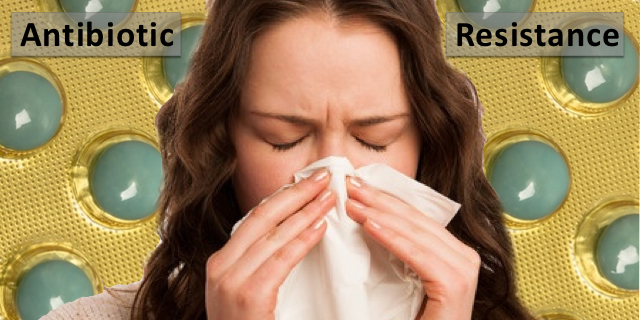What are SuperBugs?
SuperBugs are microbes like bacteria, parasites, viruses and fungi that have become resistant to treatment.
How Do Microbes Become Resistant?
Microbes are survivors. They modify themselves to guarantee their survival.
 Since the discovery of penicillin, humans have been finding and creating medications to kill microbes that make us sick. Microbes naturally adapt to these medications, eventually making treatments ineffective. Anti-microbial resistance is a long phrase for this big problem.
Since the discovery of penicillin, humans have been finding and creating medications to kill microbes that make us sick. Microbes naturally adapt to these medications, eventually making treatments ineffective. Anti-microbial resistance is a long phrase for this big problem.
2 Forms of Medication Mismanagement
 Not taking medicine for the prescribed time
Not taking medicine for the prescribed time
The anti-microbial resistance problem has become larger due to misuse of medications. By misusing medications, we help accelerate the speed that microbes develop resistance.
One common medication misuse is not taking medications as prescribed—for example, not completing the full course of a prescribed antibiotic. When your physician prescribes an antibiotic, she tells you to take it for a given amount of time. Completing that course, or set of pills over a given time, assures that all the microbes that are infecting you die.
What happens if you are prescribed 7 days of medicine but you start feeling better after 5 days  and decide to stop taking it?
and decide to stop taking it?
First, the microbes that were a little stronger–the ones that survived the first days of treatment–are allowed to live. Second, those microbes may be able to make you sick again and they may also have mutations that allowed survival. Third, you will very likely infect another person with a more resistant strain of the microbe.
 Medication Usage in Agriculture
Medication Usage in Agriculture
Antimicrobials are being used to treat animals for clinical disease, to prevent and control common disease events, and to enhance animal growth.
Nearly all dairy cows are given antibiotics like penicillin as a preventative for a disease called mastitis. Pigs receive antibiotics in their food to enhance their growth and to prevent infections. Unfortunately antibiotic resistant microbes have been found around farms and on meats in grocery stores–meaning they are getting into the food supply.
Reasons You Can’t Ignore Superbugs
WHO and CDC Warnings
Both the World Health Organization and the CDC warn we could be returning to a time when infections that have been treatable for decades can kill humans again.
In fact, there is evidence that there are pan-drug resistant microbes. Pan-drug resistant means that there are no medications left to fight these microbes. A recent journal article in Lancet indicates that the gut bacteria, E. coli– that causes serious infections elsewhere in the body when it escapes from the gut– has become immune to the only medication left that could treat it, a drug called colistin.
Additionally, the gene (MCR-1) that creates this resistance lives in something called a plasmid. Plasmids are entities that move among all types of bacteria, leaving their DNA behind. That means these plasmids can make other bacteria, besides E.coli, resistant to colistin.
No New Antibiotics For “Gram-Negative” Bacteria Available
 In January, 2016, a large group of pharmaceutical companies created and signed a Declaration by the Pharmaceutical, Biotechnology and Diagnostics Industries on Combating Antimicrobial Resistance. This document states that, over the last 40 years, there has been no new class of antibiotics to treat gram-negative bacteria approved by the FDA.
In January, 2016, a large group of pharmaceutical companies created and signed a Declaration by the Pharmaceutical, Biotechnology and Diagnostics Industries on Combating Antimicrobial Resistance. This document states that, over the last 40 years, there has been no new class of antibiotics to treat gram-negative bacteria approved by the FDA.
Urgent Threats in the US
According to the CDC, there are 18 drug resistant microbes classified as threats. The most urgent are:
• Clostridium difficile, called C. difficile, caused almost 500,000 infections and around 15,000 deaths in a single year, according to a 2015 CDC study.
• Carbapenem-Resistant Enterobacteriaceae (CRE) is a bacteria that has become resistant to most antibiotics. There are 9000 infections a year with 600 deaths.
• Neisseria gonorrhoeae which causes gonorrhea, a sexually transmitted illness, causes 820,000 infections per year. Gonorrhea can cause infertility in both men and women and if left untreated can spread throughout the body affecting the brain, heart, skin and joints.
What You Can Do?
The WHO and CDC provide a series of recommendations to protect yourself and your family from drug-resistant microbes.
• Use proper hand washing technique
• Avoiding “close contact” with those you are sick: use masks if you are sick or around people who are sick
• Do not go to work or school when sick
• Get vaccinated and stay up-to-date on vaccinations
• Take medications as prescribed and complete all courses of medications
• Never share antimicrobial medications
• Use over the counter drugs to feel better with symptom relief
• Avoid touching your eyes, mouth and nose
• Cover coughs and sneezes with a tissue or shirtsleeve
• Clean and disinfect frequently touched surfaces
Science is in a race with superbugs. The public health threat from these microbes is real. Let’s hope that joint effort between public and private sector entities in healthcare can meet the challenge.





